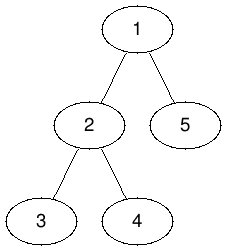CF1363E.Tree Shuffling
普及/提高-
通过率:0%
AC君温馨提醒
该题目为【codeforces】题库的题目,您提交的代码将被提交至codeforces进行远程评测,并由ACGO抓取测评结果后进行展示。由于远程测评的测评机由其他平台提供,我们无法保证该服务的稳定性,若提交后无反应,请等待一段时间后再进行重试。
题目描述
Ashish has a tree consisting of n nodes numbered 1 to n rooted at node 1 . The i -th node in the tree has a cost ai , and binary digit bi is written in it. He wants to have binary digit ci written in the i -th node in the end.
To achieve this, he can perform the following operation any number of times:
- Select any k nodes from the subtree of any node u , and shuffle the digits in these nodes as he wishes, incurring a cost of k⋅au . Here, he can choose k ranging from 1 to the size of the subtree of u .
He wants to perform the operations in such a way that every node finally has the digit corresponding to its target.
Help him find the minimum total cost he needs to spend so that after all the operations, every node u has digit cu written in it, or determine that it is impossible.
输入格式
First line contains a single integer n (1≤n≤2⋅105) denoting the number of nodes in the tree.
i -th line of the next n lines contains 3 space-separated integers ai , bi , ci (1≤ai≤109,0≤bi,ci≤1) — the cost of the i -th node, its initial digit and its goal digit.
Each of the next n−1 lines contain two integers u , v (1≤u,v≤n, u=v) , meaning that there is an edge between nodes u and v in the tree.
输出格式
Print the minimum total cost to make every node reach its target digit, and −1 if it is impossible.
输入输出样例
输入#1
5 1 0 1 20 1 0 300 0 1 4000 0 0 50000 1 0 1 2 2 3 2 4 1 5
输出#1
4
输入#2
5 10000 0 1 2000 1 0 300 0 1 40 0 0 1 1 0 1 2 2 3 2 4 1 5
输出#2
24000
输入#3
2 109 0 1 205 0 1 1 2
输出#3
-1
说明/提示
The tree corresponding to samples 1 and 2 are:
 In sample 1 , we can choose node 1 and k=4 for a cost of 4⋅1 = 4 and select nodes 1,2,3,5 , shuffle their digits and get the desired digits in every node.
In sample 1 , we can choose node 1 and k=4 for a cost of 4⋅1 = 4 and select nodes 1,2,3,5 , shuffle their digits and get the desired digits in every node.
In sample 2 , we can choose node 1 and k=2 for a cost of 10000⋅2 , select nodes 1,5 and exchange their digits, and similarly, choose node 2 and k=2 for a cost of 2000⋅2 , select nodes 2,3 and exchange their digits to get the desired digits in every node.
In sample 3 , it is impossible to get the desired digits, because there is no node with digit 1 initially.